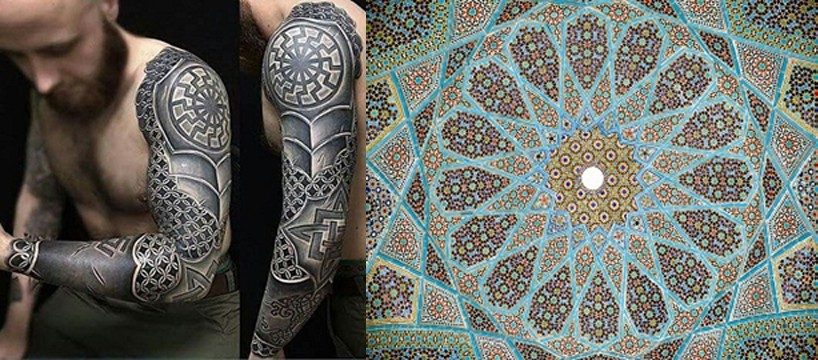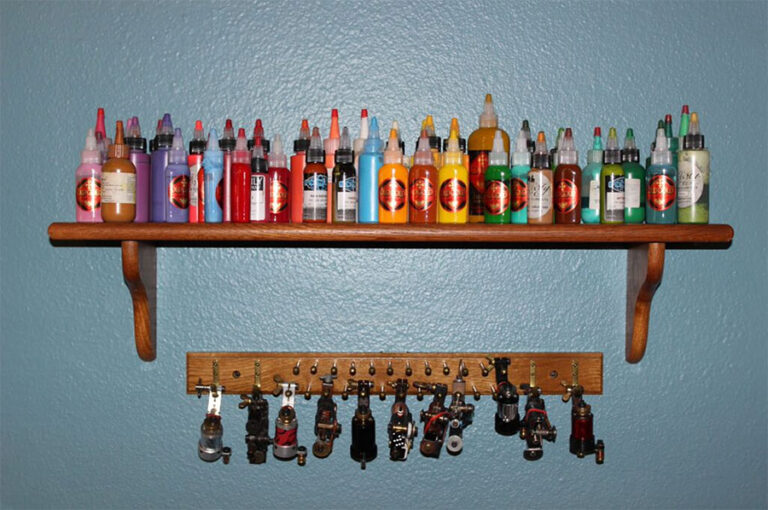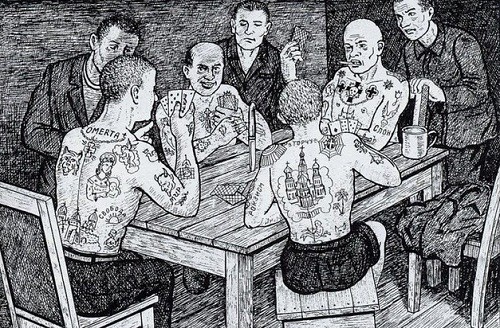Norse & Celtic Tattoos: Their Similarities, History, Meanings & Popularity
Piercing blue eyes stare out from a face spattered with blood. Thick blue lines crawl up his neck and across the side of his shaved head. He’s a warrior and his life is battle.
The Norsemen or vikingar of Scandinavia have long fascinated – and terrified – those that came into contact with them.
But were the Vikings really tattooed? There is one historical account that suggests they were.
An Arab traveler, Ahmad Ibn Fadlan, first met the Norse warriors as he traveled across Russia on a diplomatic mission. He encountered them sailing their longships down the Volga river, looking to trade with the Arab world.
He describes dark green figures of “trees” and symbols dancing from the tips of their fingers all the way up to their necks. They reminded him of the women’s gold and silver neck rings.
Similar knotwork designs are also featured in Celtic tattoos.
Since the Norwegian Vikings established significant settlements and then Kingdoms in Scotland, Ireland and the Isle of Man, it makes sense that their art should feature similar patterns.
These days, Norse and Celtic tattoos are almost interchangeable. But they still have their own stories and meanings.
Popular Celtic tattoos and their meanings
The Celtic knot is one of the most famous tattoo designs of all time, let alone celtic tattoos.
Most information relating to Celtic knots is dated to when Christian influence on the Celts began to take hold (after 450 A.D). The designs appear in a variety of early Christian manuscripts and art.
But were they ever tattooed on ancient Celts? Unfortunately, we just don’t know.
The most famous early reference to Celtic skin marking is Caesar’s commentary on the Gallic wars. He wrote that “all the Britanni paint themselves with woad”. Only in the seventh century do we learn of them pricking the skin with needles in order to create a design.
But it wasn’t until the late 20th century that celtic tattoos became popular. And it looks as though they’re here to stay.
Celtic knot tattoos are still so popular that Dublin artist Kevin McNamara actually learned his craft by tattooing Celtic knots and shamrocks on people. Interestingly, he says, they’re almost always American!
It seems as if the interlaced designs are a reflection of the Celtic belief in life’s continuity and interconnectedness.
The Celtic Love Knot features interlaced knots and supposedly represents the love between two people. It is said that the Celts used to exchange these knots in a similar way to the modern giving of wedding rings.
Arguably the best known Celtic knot is the Triquetra. Some say it’s representative of the Father, Son and Holy Spirit in Christianity, but it has Pagan meaning too.
The Celtic Cross is another hugely popular design. Again, it has significance for both Pagans and Christians. These famous symbols, like many other popular designs, have been adapted and appropriated throughout history to suit all sorts of cultures.
Popular Norse tattoos and their meanings
There are also interesting cultural influences in Norse tattoo designs.
Ibn Fadlan was writing in Arabic when he described his encounter with the Vikings. The Arabic word for “tattoo” in the original text was usually used to describe mosque decorations. This is a fitting description considering the similar geometric patterns in mosque architecture and a Norse tattoo.

The compass tattoo, or vegvisir, is a very popular Norse tattoo. It’s not from the Viking era, but apparently dates back to a 17th century Icelandic book on magic.
Another commonly seen design is the aegishjalmur or Helm of Awe. This symbol has warrior connotations to it, allowing the bearer to strike his enemies with confusion and fear. Some also say that it grants magical powers to its wearer.
The Helm of Awe represents strength and protection. A circular design, its exact meaning can be changed to suit the wearer by adding rune-like symbols around the edge of the tattoo.
Ouroboros is another design. One of Loki’s children, he is always depicted as a serpent or dragon eating its own tail. This is another design that also features in other cultures. It’s most commonly interpreted as life out of death.
Originating in ancient Egyptian iconography, the word translates in Greek as “tail” (oura) “eating” (boros) or “he who eats the tail”. It probably found its way into Norse mythology via Greek magical tradition.
The Horn Triskelion, which resembles the Celtic Triquetra, shows the god Odin’s three drinking horns intertwined. Translated from Greek, the word triskelion means “three-pronged” or legged.
This tattoo has a cool story behind it. In Norse mythology, Odin bargained for three nights with the giantess Gunnlöð for three sips of the “mead of poetry” (skáldskaparmjöðr). But instead of a sip, each time he drank a whole horn. Since all of the mead was split between the three horns, Odin ended up getting all of it, and in the end he fled in the shape of an eagle.
Now that’s ballsy.
If you like a drink (or tricking giant women), maybe that’s the design for you. Whatever you go for, whether Celtic or Norse, it doesn’t actually matter what it means. What’s important is what it means to you.






